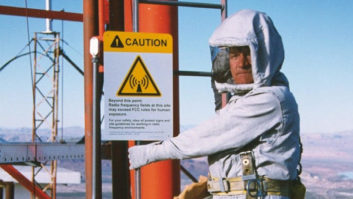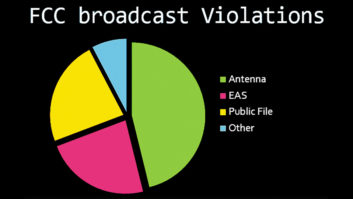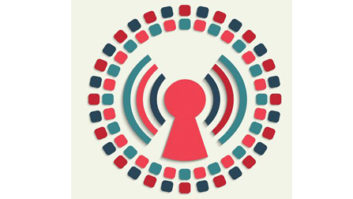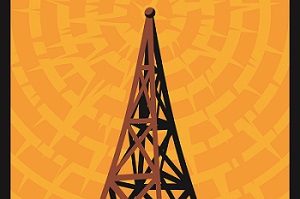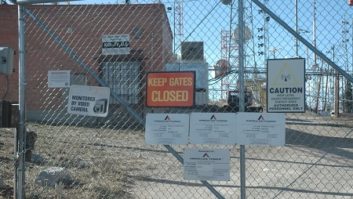Our thanks to Richard Tell Associates for the images used in this article. These signs are available here.
Last summer I wrote an article here addressing broadcaster responsibilities for signage at tower sites.
The next step in addressing signage responsibilities looks to invisible dangers at broadcast sites, areas where people may be exposed to radiofrequency or “RF” radiation. This is a complicated matter and requires reference and cross-reference to two sections in the FCC rules: Sections 1.1307 and 1.1310. (You can look up any rules we cite in this article on the Code of Federal Regulations’ website.)
The latter section sets forth limits for maximum permissible exposure to radiofrequency electromagnetic fields and puts them into two categories: (1) limits for occupational/controlled exposure and (2) limits for general population/uncontrolled exposure. The limits are in a chart that in the rules at 47 CFR 1.1310(e)(1) or at this link.
Occupational/controlled exposure: This limit applies to station employees and contractors. Such individuals must be made “fully aware” of the potential for exposure and be permitted to “exercise control.”
To be fully aware, they must have received written verbal information that fully explains the potential for RF exposure.
“Exercising control” means that the employees or contractors, except for transient persons, have received appropriate training regarding work practices relating to controlling or mitigating their exposure, and are permitted to use those practices to reduce or avoid exposure, such as through the use of personal protective equipment or time averaging of exposure.
Uncontrolled exposure: This category pertains to the general population and relates to uncontrolled situations where the public may be exposed as a consequence of their employment and may not be fully aware of the potential for exposure or cannot exercise control over their exposure.
For these purposes, FCC rules require all applications for a construction permit or license, their renewals or any other authorizations for radiofrequency sources to either:
(A) Determine that they qualify for an exemption under the calculations defined at § 1.1307(b)(3);
(B) Prepare an evaluation of the human exposure to RF radiation pursuant to § 1.1310 and include in the application a statement confirming compliance with the limits in § 1.1310; or
(C) Prepare an Environmental Assessment if those RF sources would cause human exposure to levels of RF radiation in excess of the limits in § 1.1310.
RF Safety Plan
Where fixed RF sources are located, the rules require specific mitigation actions with signage to ensure compliance with the exposure limits, including implementation of an RF safety plan, restriction of access to the RF sources, and disclosure of where exposure limits are exceeded. See § 1.1307(b)(4).
For this purpose, the rules divide areas subject to RF radiation into four defined categories:
- Category One is any spatial region that is compliant with the general population exposure limit with continuous exposure or source-based time-averaged exposure;
- Category Two is any spatial region where the general population exposure limit is exceeded but that is compliant with the occupational exposure limit with continuous exposure;
- Category Three is any spatial region where the occupational exposure limit is exceeded by no more than 10 times the limit;
- Category Four is any spatial region where the exposure is more than 10 times the occupational exposure limit or where there is a possibility for serious injury on contact.
All RF exposure advisory signs must be viewable and readable from the boundary where the applicable exposure limits are exceeded and include at least the following five components:
- The appropriate signal word and associated color, i.e., “DANGER” (red), “WARNING” (orange), “CAUTION,” (yellow) “NOTICE” (blue);
- RF energy advisory symbol;
- An explanation of the RF source;
- Behavior necessary to comply with the exposure limits; and
- Up-to-date contact information.
The basic required mitigation actions are as follows. The sample RF exposure sign graphics are provided by Richard Tell Associates Inc.
Category One — INFORMATION: No mitigation actions are required. The rules suggest that an optional green “INFORMATION” sign is useful.
The sign should provide a description of the RF source, contact information and a reminder to obey all postings and boundaries in accordance with Section 5.8 of IEEE Std C95.2-1999.

Category Two — NOTICE: The equipment owner must (1) post signs and (2) control access to the area where the general population exposure limit is exceeded. The signs must contain the signal word “NOTICE” and the blue color. Signs must contain the five components discussed above. In some cases, a sign containing the components and attached directly to the antenna is sufficient, provided the required mitigation action is legible at the proper distance.
Access to the area where the continuous exposure limit is exceeded for the general population must be limited. This can be done through a variety of ways such as fencing, placing the equipment on a rooftop that has limited access, etc. Training is required for occupational personnel with access to controlled areas, and transient individuals must use time averaging and be properly supervised as specified in the rules.
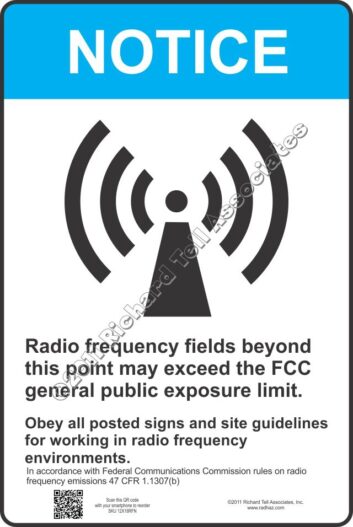
Category Three — CAUTION: In addition to the access requirements of Category Two above, the equipment owner must (1) post signs and/or (2) utilize additional controls, or indicators. Signs must use the signal word “CAUTION” and the associated yellow color. The sign must also include the information in the five categories above.
If the Category Three boundaries overlap the Category Two area, then the Category Two sign is optional at places where two signs would otherwise be required. Here, too, a label or small sign may be attached directly to the surface of an antenna if it specifies a minimum approach distance.
Additional boundary controls should be utilized to surround the area where the occupational exposure limit is exceeded. This can be done through chains, railings, contrasting paint, diagrams, etc.
Transient individuals are not permitted in any Category Three areas when the occupational exposure limit is exceeded and the rules require reducing exposure time in the area where the occupational exposure limit is exceeded. Proper use of RF personal protective equipment may be used as an alternative to limiting time exposure.

Category Four — WARNING/DANGER: In addition to Category Two access controls, the equipment owner must (1) post signs and (2) utilize additional controls or indicators. The “WARNING” signs with the associated orange color are required where the occupational limit is exceeded by a factor of 10, and “DANGER” signs with the associated color of red are required where immediate and serious injury will occur on contact. In both instances, the sign must contain the information from the five categories outlined above.

If the boundaries between Category Three and Four would require overlapping signs at same location, then the Category Three sign is optional.
Additional boundary controls should be utilized to surround the area where the occupational exposure limit is exceeded. This can be done through chains, railings, contrasting paint, diagrams, etc.

Where power reduction, and therefore Category reduction, is not feasible, lockout/tagout procedures must be followed to prevent access.
Complex topic
Section 1.1307 of the commission’s rules identifies actions that may have a significant environmental effect and for which an environmental assessment may be required. The locations identified are where RF facilities are in an officially designated wildlife area or preserve, facilities that may affect threatened or endangered species or designated critical habitats or are likely to jeopardize their continued existence.
Another protected category includes facilities that could affect sites or objects of significance to American history, archaeology, engineering or culture or are listed in the National Registry of Historic places, that may affect Indian religious sites or are located in floodplains.
Applicants for FCC authorizations that include radiofrequency sources must either make a determination that they qualify for an exemption, prepare an evaluation of the human exposure to RF radiation and include in the application a statement of compliance or prepare an Environmental Assessment. Compliance for fixed RF sources may also be accomplished with mitigation actions as described in this article.
Interpretation of these rules can be extremely complex. It is crucial that when licensees are interpreting and implementing these rules, they consult and consider the advice of their counsel and experienced engineering staff.
This column is provided for general information purposes only and should not be relied upon as legal advice pertaining to any specific factual situation. Legal decisions should be made only after proper consultation with a legal professional of your choosing.

